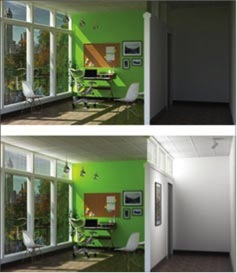Two researchers of University of Cincinnati have found the way, how to bring the light into the building interiors. By employing the tiny electrofluidic cells and series of open-air “ducts”, the sunlight can reach even the most hidden parts of windowless workspaces deep inside the office buildings. This new technology is called SmartLight and can be the key point for energy savings while enjoying the sunlight even at work 🙂
Even there is a huge amount of energy coming to the Earth from the Sun, today’s technologies aren’t very efficient. A typical photovoltaic array loses most of the sun’s energy when it gets converted into electricity. But with SmartLight installed, the sunlight is channeled through the system in its original form, so that the energy loss is eliminated.

A room with SmartLight off (above) and on (below)
This revolutionary method is far more efficient than converting the light into electricity, and then back into light. Moreover, it is much more sustainable than generating electric light by burning fossil fuels or using nuclear energy.
Elecro fluid technology is suitable for any building, and can be especially useful for large buildings, since 21% of commercial sector electricity consumption goes toward lighting.
SmartLight technology works this way: A narrow grid of electrofluidic cells, which is self-powered by embedded photovoltaic, is applied near the top of a window. Each tiny cell – only a few millimeters wide – contains fluid with optical properties as good or better than glass. The surface tension of the fluid can be rapidly manipulated into shapes such as lenses or prisms through minimal electrical stimulation – about 10,000 to 100,000 times less power than what’s needed to light a traditional incandescent bulb. In this way, sunlight passing through the cell can be controlled.
The grid is able to direct some light to the ceiling, where the light is reflected and ambient room lighting is provided. Other portion of light can be aimed toward special fixtures for task lighting, or across the empty upper spaces in a room to a transom window where another electrofluidic grid is installed. From this point on, the process can be repeated, so that the sunlight can reach the deepest areas of any building. All this is possible without installing new wiring, ducts, tubes or cables. SmartLight can be installed into an existing architecture without any problem.
Moreover, SmartLight can be controlled wirelessly by means of a mobile software application. Instead of using a manual light switch on the wall, a user indicates his preferences through an application on his mobile phone or tablet. SmartLight can even coordinate user’s presence or movement in the room with the light level required.
There will be no more light switches on the walls. You just walk into the room and the light turns on because your smartphone knows, where you are.
What happens when a night or a cloudy day comes? SmartLight possess an energy storage ability, which won’t let you find yourself in a dark. On a sunny day, there is often hundreds of times greater amount of sunlight than needed. SmartLight can funnel surplus light into a centralized energy-storing hub inside the building. This stored light can later be used to beam electrical lighting when natural light levels are low.
SmartLight reacts dynamically – each cell can switch by the second. During the day, the light levels vary according to the current needs, so the illumination remains constant.
Thanks to its energy storage potential, the stockpiled energy can be used to power other needs, such as heating and cooling. And if the surplus sunlight collection is not possible in some building, the light can even be sent to a neighboring collection facility.
According to its creators, most of the technology required for the SmartLight commercial use already exists. Recently, they have begun evaluating materials and manufacturing methods. The only thing missing is enough money to create a large-scale prototype that could attract the government or industry partners.
SOURCE:
- University of Cincinnati: Electrofluidic Technology Could Revolutionize The Lighting Industry, pubished in Lighting Technology, Winter 2014
